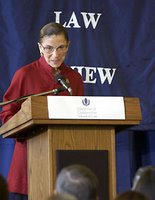 Memorable experiences have a way of dropping in on you when you least expect them to. Take today for instance.
Memorable experiences have a way of dropping in on you when you least expect them to. Take today for instance. All the tickets to the event had supposedly been claimed long ago, but I figured there was no harm in trying to finagle my way into the auditorium where the panel was being held. Surprisingly enough, no finagling was required. There wasn’t even security at the door (a seemingly shocking oversight). The organizers had opted to allow standing room attendance and so the crowds were packing in at the rear of the auditorium. To avoid the inevitable purge of the tightly packed back end of the lecture hall, I pushed through the swarming masses and settled in near the front of the hall by the far right corner of the stage. In doing so, I not only managed to elude the subsequent effort to thin the crowd, but I was able to see Justice Ginsburg speak up close, from no more than twenty feet away.
Justice Ginsburg is very petite and struck me as rather soft-spoken, but she is nonetheless a commanding presence. In reminiscing about the Chief Justice, it was clear that she had a genuine affection for him. She called him the “best boss she’s ever had” and lauded his evenhanded approach in overseeing the administration of the Court. She said he was always imminently fair in assigning out the responsibility to write opinions, and in the bi-monthly conferences he chaired, she could never remember him ever disparaging another Justice for his or her position on an issue. She also made note of the sensitivity and kindness he showed her when she battled colon cancer in 1999.
In reflecting on Rehnquist’s legacy, Justice Ginsburg acknowledged some of her differences with his interpretative approach to the Constitution, but she noted two cases in particular where his votes had pleasantly surprised her. The first was in Weinberger v. Wiesenfeld, a case she actually argued before the Court in 1975 that involved a gender-based distinction mandated by the Social Security Act. Rehnquist concurred in the Court’s decision to strike down the distinction on the grounds that it failed a rational basis review. And the second was in United States v. Virginia, a 1996 case involving an equal protection claim against the Virginia Military Institute. Ginsburg, then an Associate Justice on the Court, authored the majority opinion, and Rehnquist again concurred in the result, finding no substantially related “important governmental objectives” to justify the exclusion of women at VMI.
In ending, Ginsburg remarked that a Chief Justice brings only him or her-self into the position. Chief Justices are given tools which allow them to be first among equals, but their influence and greatness depend entirely on how they handle those tools. Justice Rehnquist, she said, handled them masterfully. Not having had much exposure to Justice Ginsburg outside an opinion here or there in a law school textbook, I left thoroughly impressed. What struck me most was the collegiality that clearly exists between the Justices in spite of philosophical differences that sometimes run deep. A memorable experience to be sure on what would otherwise have been another ordinary day.






No comments:
Post a Comment